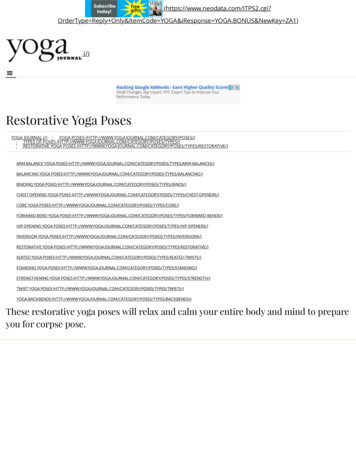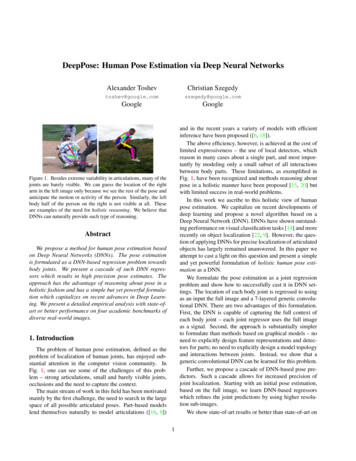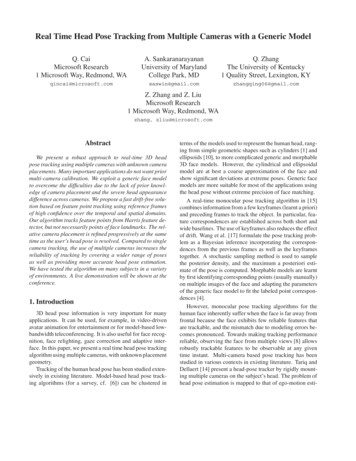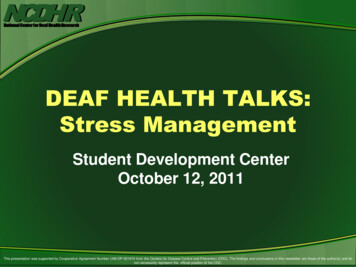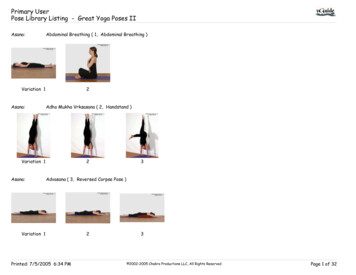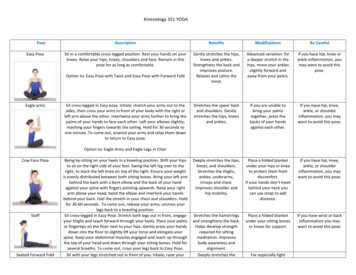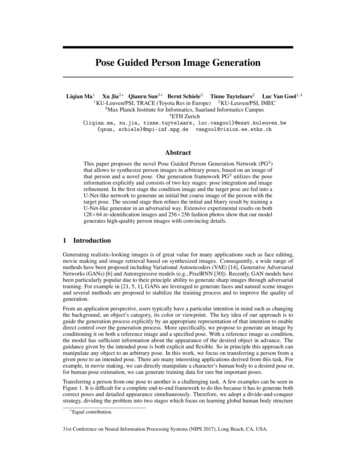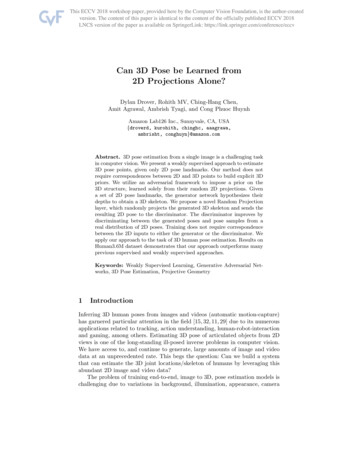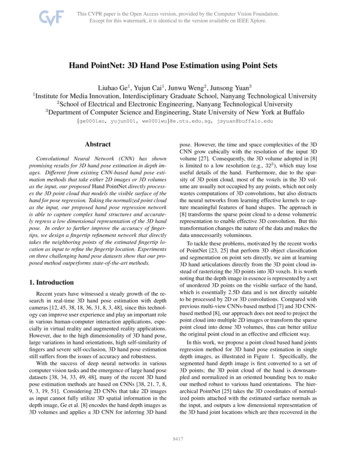
Transcription
Hand PointNet: 3D Hand Pose Estimation using Point SetsLiuhao Ge1 , Yujun Cai1 , Junwu Weng2 , Junsong Yuan31Institute for Media Innovation, Interdisciplinary Graduate School, Nanyang Technological University2School of Electrical and Electronic Engineering, Nanyang Technological University3Department of Computer Science and Engineering, State University of New York at Buffalo{ge0001ao, yujun001, we0001wu}@e.ntu.edu.sg, jsyuan@buffalo.eduAbstractConvolutional Neural Network (CNN) has shownpromising results for 3D hand pose estimation in depth images. Different from existing CNN-based hand pose estimation methods that take either 2D images or 3D volumesas the input, our proposed Hand PointNet directly processes the 3D point cloud that models the visible surface of thehand for pose regression. Taking the normalized point cloudas the input, our proposed hand pose regression networkis able to capture complex hand structures and accurately regress a low dimensional representation of the 3D handpose. In order to further improve the accuracy of fingertips, we design a fingertip refinement network that directlytakes the neighboring points of the estimated fingertip location as input to refine the fingertip location. Experimentson three challenging hand pose datasets show that our proposed method outperforms state-of-the-art methods.1. IntroductionRecent years have witnessed a steady growth of the research in real-time 3D hand pose estimation with depthcameras [12, 45, 38, 18, 36, 31, 8, 3, 48], since this technology can improve user experience and play an important rolein various human-computer interaction applications, especially in virtual reality and augmented reality applications.However, due to the high dimensionality of 3D hand pose,large variations in hand orientations, high self-similarity offingers and severe self-occlusion, 3D hand pose estimationstill suffers from the issues of accuracy and robustness.With the success of deep neural networks in variouscomputer vision tasks and the emergence of large hand posedatasets [38, 34, 33, 49, 48], many of the recent 3D handpose estimation methods are based on CNNs [38, 21, 7, 8,9, 3, 19, 51]. Considering 2D CNNs that take 2D imagesas input cannot fully utilize 3D spatial information in thedepth image, Ge et al. [8] encodes the hand depth images as3D volumes and applies a 3D CNN for inferring 3D handpose. However, the time and space complexities of the 3DCNN grow cubically with the resolution of the input 3Dvolume [27]. Consequently, the 3D volume adopted in [8]is limited to a low resolution (e.g., 323 ), which may loseuseful details of the hand. Furthermore, due to the sparsity of 3D point cloud, most of the voxels in the 3D volume are usually not occupied by any points, which not onlywastes computations of 3D convolutions, but also distractsthe neural networks from learning effective kernels to capture meaningful features of hand shapes. The approach in[8] transforms the sparse point cloud to a dense volumetricrepresentation to enable effective 3D convolution. But thistransformation changes the nature of the data and makes thedata unnecessarily voluminous.To tackle these problems, motivated by the recent worksof PointNet [23, 25] that perform 3D object classificationand segmentation on point sets directly, we aim at learning3D hand articulations directly from the 3D point cloud instead of rasterizing the 3D points into 3D voxels. It is worthnoting that the depth image in essence is represented by a setof unordered 3D points on the visible surface of the hand,which is essentially 2.5D data and is not directly suitableto be processed by 2D or 3D convolutions. Compared withprevious multi-view CNNs-based method [7] and 3D CNNbased method [8], our approach does not need to project thepoint cloud into multiple 2D images or transform the sparsepoint cloud into dense 3D volumes, thus can better utilizethe original point cloud in an effective and efficient way.In this work, we propose a point cloud based hand jointsregression method for 3D hand pose estimation in singledepth images, as illustrated in Figure 1. Specifically, thesegmented hand depth image is first converted to a set of3D points; the 3D point cloud of the hand is downsampled and normalized in an oriented bounding box to makeour method robust to various hand orientations. The hierarchical PointNet [25] takes the 3D coordinates of normalized points attached with the estimated surface normals asthe input, and outputs a low dimensional representation ofthe 3D hand joint locations which are then recovered in the8417
Figure 1: Overview of our proposed Hand PointNet-based method for 3D hand pose estimation in single depth images. Wenormalize the 3D point cloud in an oriented bounding box (OBB) to make the network input robust to global hand rotation.The 3D coordinates of sampled and normalized points attached with estimated surface normals are fed into a hierarchicalPointNet [25], which is trained in an end-to-end manner, to extract hand features and regress 3D joint locations. The fingertiprefinement PointNet can further improve the estimation accuracy of fingertip locations.camera coordinate system. The fingertip locations are further refined by a basic PointNet which takes the neighboring points of the estimated fingertip location as input. Toour knowledge, this is the first work that regresses 3D handjoint locations directly from the 3D point cloud using a deepneural network, which is able to capture 3D structures ofthe hand and estimate 3D hand pose accurately in real-time.Our main contributions are summarized as follows: We propose to estimate 3D hand joint locations directlyfrom 3D point cloud based on the network architectureof PointNet [23, 25]. Compared with 2D CNN-basedand multi-view CNNs-based methods [38, 7, 9, 3, 19],our method can better exploit the 3D spatial information in the depth image; compared with 3D CNN-basedmethod [8], our method can effectively leverage more information in the depth image to capture more details ofthe hand with fewer number of network parameters. In order to make our method robust to variations in handglobal orientations, we propose to normalize the sampled3D points in an oriented bounding box without applyingany additional network to transform the hand point cloud.The normalized point clouds with more consistent globalorientations make the PointNet easier to learn 3D handarticulations. We propose to refine the fingertip locations with a basicPointNet that takes the neighboring points of the estimated fingertip location as input to regress the refined fingertip location. The refinement network can further exploitfiner details in the original point cloud and regress moreaccurate fingertip locations.We conduct comprehensive experiments on three challenging hand pose datasets [33, 34, 38] to evaluate ourmethods. Experimental results show that our proposedHand PointNet-based method for 3D hand pose estimation is superior to state-of-the-art methods on all the threedatasets, with runtime speed of over 48fps.2. Related WorkHand Pose Estimation: Hand pose estimation methodscan be divided into discriminative approaches [12, 45, 16,38], generative approaches [22, 1, 39, 13, 26] and hybridapproaches [28, 36, 35]. In this section, we focus on deepneural networks-based discriminative approaches.Some sophisticated neural networks have been exploredfor 3D hand pose estimation, such as the feedback loopmodel [21], spatial attention network [47], region ensemblenetwork [9], deep generative models [41], etc. Hand jointconstraints are integrated into deep learning approaches toavoid implausible hand poses. Oberweger et al. [20, 19]exploit a hand prior to constrain the hand pose. Zhou etal. [50] train a CNN to regress hand model parameters andinfer hand pose via forward kinematics. Some other methods focus on different input representations. Ge et al. [7, 8]apply multi-view CNNs and 3D CNN for 3D hand pose estimation which take projected images on multiple views and3D volumes as input, respectively, in order to better utilizethe depth information. Choi et al. [3] adopt geometric features as additional input modality to estimate hand posesthrough multi-task learning. However, none of these methods directly take the point cloud as the neural network input.3D Deep Learning: Multi-view CNNs-based approaches [32, 24, 7, 2] project 3D points into 2D images and use2D CNNs to process them. 3D CNN-based methods [44,17, 24, 30, 8] rasterize 3D points into 3D voxels for 3D convolution. 3D CNNs based on octrees [27, 43] are proposedfor efficient computation on high resolution volumes.PointNet [23, 25] is a recently proposed method that directly takes point cloud as network input. Similar to PointNet, deep Kd-networks [15] is a recently proposed networkarchitecture that directly consumes point cloud by adoptinga Kd-tree structure. These methods have shown promisingperformance on 3D classification and segmentation tasks,but have not been applied to articulated pose regression.8418
3. MethodologyOur proposed 3D hand pose estimation method takes adepth image containing a hand as the input and outputs aMset of 3D hand joint locations Φ {φm }m 1 Λ in thecamera coordinate system (C.S.), where M is the number ofhand joints, Λ is the 3 M dimensional hand joint space.The hand depth image is converted to a set of 3D points.The 3D point set is downsampled to N points pi R3(i 1, · · · , N ), and normalized in an oriented boundingbox (OBB). A hierarchical PointNet [25] takes N pointsas the input to extract hierarchical hand features and regressthe 3D hand pose. The dimension of each input point isD d C0 , which is composed of d-dim coordinate andC0 -dim input feature. In this work, d 3, and C0 3 sincewe adopt the estimated 3D surface normal as the input feature. To further improve the estimation accuracy of fingertiplocations, a fingertip refinement network is designed. In thefollowing sections, we first briefly review the mechanism ofPointNet, then present our proposed 3D hand pose estimation method.Figure 2: Basic architecture of PointNet. The network directly takes N points as the input. Each D-dim input pointis mapped into a C-dim feature through MLP. Per-point features are aggregated into a global feature by max-pooling.The global feature is mapped into an F -dim output vector.3.1. PointNet RevisitedBasic PointNet: PointNet [23] is a type of neuralnetwork that directly takes a set of points as the inputand is able to extract discriminative features of the pointcloud. As shown in Figure 2, each input point xi RD(i 1, · · · , N ) is mapped into a C-dim feature vectorthrough multi-layer perceptron (MLP) networks, of whichthe weights across different points are shared. A vector maxoperator is applied to aggregate N point feature vectors into a global feature vector that is invariant to permutationsof input points. Finally, the C-dim global feature vector ismapped into an F -dim output vector using MLP networks.It has been proved in [23] that PointNet has the ability to approximate arbitrary continuous set functions, given enoughneurons in the network.Hierarchical PointNet: The main limitation of the basic PointNet is that it cannot capture local structures of thepoint cloud in a hierarchical way. To address this problem,Qi et al. [25] proposed a hierarchical PointNet which hasbetter generalization ability due to its hierarchical featureextraction architecture. In this paper, we exploit the hierarchical PointNet for 3D hand pose estimation. As shownin Figure 1, the hierarchical PointNet consists of L pointset abstraction levels. At the l-th level (l 1, · · · , L 1),Nl points are selected as centroids of local regions; the knearest neighbors of the centroid point are grouped as alocal region; a basic PointNet with shared weights acrossdifferent local regions is applied to extract a Cl -dim featureof each local region; Nl centroid points with d-dim coordinates and Cl -dim features are fed into the next level. At thelast level, a global point cloud feature is abstracted from thewhole input points of this level by using a basic PointNet.Figure 3: Examples of OBB-based point cloud normalization. The 1st and 3rd columns present the original pointclouds in the camera C.S. with various hand orientations.The 2nd and 4th columns present the sampled and rotatedpoint clouds in the OBB C.S., of which the hand orientations are more consistent. We color-code all point clouds toshow the relative z coordinate value.3.2. OBB-based Point Cloud NormalizationOne challenge of 3D hand pose estimation is the largevariation in global orientation of the hand. The objectivefor hand point cloud normalization is to transform the original hand point cloud into a canonical coordinate system inwhich the global orientations of the transformed hand pointclouds are as consistent as possible. This normalization stepensures that our method is robust to variations in hand global orientations.If the output is invariant to the rotation of input pointcloud, such as the outputs in semantic labeling tasks [23],we can add a spatial transformation network [11, 23] intothe PointNet to predict the transformation matrix, as proposed in [23]. However, in our problem, the output 3Dhand pose depends on the orientation of the input hand pointcloud, which makes the network difficult to be trained in an8419
Figure 4: Visualization of the point sensitivity in different regions to different filters at three set abstraction levels. At eachof the first two levels, each column corresponds to the same local region, and each row corresponds to the same filter. Forillustration purpose, we only show the sensitivity of points in three local regions to two filters at each of the first two levels;At the third level, we show the sensitivity of points to six filters. Points with high sensitivity are shown in red color, andpoints with low sensitivity are shown in blue color. Points that do not belong to the local region are shown in gray color.end-to-end manner. Some solutions could be designing two parallel networks to estimate the canonical hand poseand the hand orientation at the same time [51] or adding aspatial de-transformation network before the output layer toremap the estimated pose to the original C.S. [5]. But thesesolutions will increase the complexity of the network andmake the training more difficult.In this work, we propose a simple yet effective method tonormalize the 3D hand point cloud in OBB, instead of applying any additional networks to estimate the hand globalorientation or transform the hand point cloud. OBB is atightly fitting bounding box of the input point cloud [40].The orientation of OBB is determined by performing principal component analysis (PCA) on the 3D coordinates ofinput points. The x, y, z axes of the OBB C.S. are alignedwith the eigenvectors of input points’ covariance matrix,which correspond to eigenvalues from largest to smallest,respectively. The original points in camera C.S. are firsttransformed into OBB C.S., then these points are shifted tohave zero mean and scaled to a unit size:Tcampobb (Robb) · pcam , pnor pobb p̄obb Lobb ,(1)camwhere Robbis the rotation matrix of the OBB in cameracamC.S.; pand pobb are 3D coordinates of point p in cameraC.S. and OBB C.S., respectively; p̄obb is the centroid of N; Lobb is the maximum edge lengthpoint cloud pobbii 1norof OBB; pis the normalized 3D coordinate of point p inthe normalized OBB C.S.During training, the ground truth 3D joint locations incamera C.S. also apply the transformation in Equation 1 toobtain the 3D joint locations in the normalized OBB C.S.During testing, the estimated 3D joint locations in the nor-malized OBB C.S. φ̂norm are transformed back to those incamera C.S. φ̂cam(m 1, · · · , M ):m camobbφ̂cam Robb· Lobb · φ̂nor.(2)mm p̄Figure 3 presents some examples of the original handpoint clouds and the corresponding normalized hand pointclouds. As can be seen, although the orientations of originalhand point clouds in camera C.S. have large variations, theorientations of normalized hand point cloud in OBB C.S.are more consistent. Experiments are conducted in Section 4.1 to show that our proposed OBB-based point cloudnormalization method can improve the performance of boththe basic PointNet and the hierarchical PointNet.3.3. Hand Pose Regression NetworkWe design a 3D hand pose regression network whichcan be trained in an end-to-end manner. The input of thehand pose regression network is a set of normalized pointsNnornor NnorX nor {xnorisi }i 1 {(pi , ni )}i 1 , where pithe 3D coordinate of the normalized point and nnorisithe corresponding 3D surface normal. These N pointsare then fed into a hierarchical PointNet [25], as shownin Figure 1, which has three point set abstraction levels.The first two levels group input points into N1 512 andN2 128 local regions, respectively. Each local regioncontains k 64 points. These two levels extract C1 128and C2 256 dimensional features for each local region,respectively. The last level extracts a 1024-dim global feature vector which is mapped to an F -dim output vector bythree fully-connected layers. We present the detailed hierarchical PointNet architecture in the supplementary material.Since the degree of freedom of human hand is usually lower than the dimension of 3D hand joint locations8420
(3 M ), the PointNet is designed to output an F -dim(F 3 M ) representation of hand pose to enforcehand pose constraint and alleviate infeasible hand poseestimations, which is similar to [20]. In the trainingphase, given T training samples with the normalized pointcloud and the corresponding ground truth 3D joint locationsT{(Xtnor , Φnort )}t 1 , we minimize the following objectivefunction:w arg minwTX22kαt F (Xtnor , w)k λkwk(3)t 1where w denotes network parameters; F represents thehand pose regression PointNet; λ is the regularizationstrength; αt is an F -dim projection of Φnort . By performing PCA on the ground truth 3D joint locations in the training dataset, we can obtain αt E T · (Φnor u), wheretE denotes the principal components, and u is the empiricalmean. During testing, the estimated 3D joint locations arereconstructed from the network outputs:Φ̂nor E · F (X nor , w ) u.(4)In Figure 4, we visualize the sensitivity of points indifferent regions to different filters at three set abstractionlevels in a well trained three-level hierarchical PointNet.The corresponding input is the example shown in Figure 1.We normalize per-point features in the same region extracted by the same filter between 0 and 1. Large normalizedfeature value means that the corresponding point is sensitive to the filter. As can be seen in Figure 4, from low levelto high level, the size of receptive field in Euclidean spacebecomes larger and larger. At the first two levels, filtersextract features from local regions, and different filters exaggerate different local structures in the local region. At thehighest level, filters extract features from the whole inputpoints of this level, and different filters exaggerate different parts of the hand, such as different fingers, hand palm,etc. With such a hierarchical architecture, the network cancapture structures of the hand from local to global.3.4. Fingertip Refinement NetworkTo further improve the estimation accuracy of fingertiplocations, we design a fingertip refinement network whichtakes K nearest neighboring points of the estimated fingertip location as input and outputs the refined 3D location ofthe fingertip, as shown in Figure 5. We refine fingertip locations for two reasons: first, the estimation error of fingertiplocations is usually relatively large compared to other joints,as shown in experimental results in Section 4.1; second, thefingertip location of straightened finger is usually easy tobe refined, since the K nearest neighboring points of thefingertip will not change a lot even if the estimated locationdeviates from the ground truth location to some extent whenK is relatively large.Figure 5: Illustration of fingertip refinement. K nearestneighboring points of the estimated fingertip location arefound in the original hand point cloud with upper limit ofpoint number. These points are normalized and fed into abasic PointNet that outputs the refined fingertip 3D location.Numbers in parentheses of MLP networks are layer sizes.Since we only refine fingertips for straightened fingers,we first check each finger is bent or straightened by calculating joint angles using the joint locations. For thestraightened finger, we find the K nearest neighboringpoints of the fingertip location in the original point cloudwith upper limit of point number to ensure real-time performance. The K nearest neighboring points are then normalized in OBB, which is similar to the method in Section 3.2. A basic PointNet takes these normalized points asinput and outputs the refined fingertip 3D location. Duringthe training stage, we use the ground truth joint locations tocalculate joint angles; for the fingertip location used in thenearest neighbor search, we add a 3D random offset withina radius of r 15mm to the ground truth fingertip locationin order to make the fingertip refinement network more robust to inaccurate fingertip estimations. During the testingstage, we use joint locations estimated by the hand pose regression network for calculating joint angles and searchingnearest neighboring points.3.5. Implementation DetailsThe 3D surface normal is approximated by performingPCA on the nearest neighboring points of the query point inthe sampled point cloud to fit a local plane [10]. The number of nearest neighboring points is set as 30. For the hierarchical PointNet, followed by [25], we use farthest pointsampling method to sample centroids of local regions andball query to group points. The radius for ball query is setas 0.1 at the first level and 0.2 at the second level. The output dimension of the hand pose regression network F is setas 2 M , which is 2/3 of the dimension of the hand jointlocations.For training PointNets, we use Adam [14] optimizer withinitial learning rate 0.001, batch size 32 and regularizationstrength 0.0005. The learning rate is divided by 10 after 508421
30405060D: error threshold (mm)70801020304050D: error threshold (mm)6070080Mean200%0Little T1010 %Ring T0%05Basic PointNet, w/o OBB (15.5mm)Basic PointNet, OBB (12.2mm)Hierarchical PointNet, w/o OBB (13.6mm)Hierarchical PointNet, OBB (10.8mm)Little R10 %20 %10Ring RN 512 (13.1mm)N 1024 (12.2mm)N 2048 (12.0mm)30 %Middle T20 %40 %15Index T30 %50 %20Middle R40 %60 %Index R50 %70 %Thumb T60 %80 %Palm70 %Basic PointNet, w/o OBB (15.5mm)Basic PointNet, OBB (12.2mm)Hierarchical PointNet, w/o OBB (13.6mm)Hierarchical PointNet, OBB (10.8mm)25Mean error distance (mm)80 %30Thumb R90 %Proportion of frames with worst error D100 %90 %Proportion of frames with worst error D100 %Figure 6: Self-comparison of different methods on NYU dataset [38]. Left: the impact of different numbers of sampledpoints on the proportion of good frames. Middle & Right: the impact of different PointNet architectures and normalizationmethods on the proportion of good frames as well as on the per-joint mean error distance (R: root, T: tip). The overall meanerror distances are shown in parentheses.16w/o Fingertip Refinementwith Fingertip Refinement1514Mean error distance (mm)epochs. The training process is stopped after 60 epochs.For fingertip refinement, we set the number of nearestneighboring points K as 256. Considering the real-timeperformance, we downsample the original point cloud toN ′ 6000 points with random sampling when the numberof points in the original point cloud exceeds the upper limit N ′ , and we apply Kd-tree algorithm [6] in the efficientnearest neighbor search.1312111098NYU DatasetMSRA DatasetMeanRing TLittle TMiddle TIndex TThumb TMeanLittle TRing TMiddle TIndex TThumb TMeanRing TLittle TIndex TWe evaluate our proposed method on three public handpose datasets: NYU [38], MSRA [33] and ICVL [34].The NYU dataset [38] contains more than 72K trainingframes and 8K testing frames. Each frame contains 36 annotated joints. Following previous works [38, 21, 8], weestimate a subset of M 14 joints. We segment the handfrom the depth image using random decision forest (RDF)similar to [34]. Since the segmented hands may containarms with various lengths, we augment the training datawith random arm lengths.The MSRA dataset [33] contains more than 76K framesfrom 9 subjects. Each subject contains 17 gestures. In eachframe, the hand has been segmented from the depth imageand the ground truth contains M 21 joints. The neuralnetworks are trained on 8 subjects and tested on the remaining subject. We repeat this experiment 9 times for all subjects and report the average metrics. We do not perform anydata augmentation on this dataset.The ICVL dataset [34] contains 22K training frames and1.6K testing frames. The ground truth of each frame contains M 16 joints. We apply RDF for hand segmentationand augment the training data with random arm lengths aswell as random stretch factors.We evaluate the hand pose estimation performance with6Middle T4. ExperimentsThumb T7ICVL DatasetFigure 7: The impact of fingertip refinement on fingertips’mean error distances and the overall mean error distance onNYU [38], MSRA [33] and ICVL [34] datasets (T: tip).two metrics: the first metric is the per-joint mean error distance over all test frames; the second metric is the proportion of good frames in which the worst joint error is belowa threshold, which is proposed in [37] and is more strict.All experiments are conducted on a workstation withtwo Intel Core i7 5930K, 64GB of RAM and an NvidiaGTX1080 GPU. The deep neural networks are implementedwithin the PyTorch framework.4.1. Self-comparisonsWe first evaluate the influence of the number of sampled points N . As shown in Figure 6 (left), we experimentwith three different numbers of sampled points by using abasic PointNet for hand pose regression on NYU dataset.When N 512, the estimation accuracy is slightly lowerthan the other two results with larger number of sampled8422
NYU Dataset100 %MSRA Dataset100 %80 %70 %80 %70 %60 %Heat map [38] (20.8mm)DeepPrior [20] (19.8mm)Feedback [21] (16.2mm)DeepModel [49] (16.9mm)DeepHand [29]Crossing Nets [41] (15.5mm)Lie X [46] (14.5mm)3D CNN [8] (14.1mm)Hallucination Heat [3]REN [9] (13.4mm)DeepPrior [19] (12.3mm)Ours (10.5mm)50 %40 %30 %20 %10 %0%01020304050D: error threshold (mm)607070 %60 %60 %50 %50 %Hierarchical [33] (15.2mm)Collaborative Filtering [4]Multi view CNNs [7] (13.1mm)LSN, Finger Jointly Regression [42]LSN, Pose Classification [42]Crossing Nets [41] (12.2mm)3D CNN [8] (9.6mm)DeepPrior [19] (9.5mm)Ours (8.5mm)40 %30 %20 %10 %80Proportion of frames with worst error D90 %Proportion of frames with worst error D80 %ICVL Dataset100 %90 %Proportion of frames with worst error D90 %0%01020304050D: error threshold (mm)607080LRF [34] (12.6mm)Hierarchical [33] (9.9mm)DeepPrior [20] (10.4mm)DeepModel [49] (11.6mm)LSN [42] (8.2mm)Crossing Nets [41] (10.2mm)REN [9] (7.6mm)DeepPrior [19] (8.1mm)Ours (6.9mm)40 %30 %20 %10 %0%01020304050D: error threshold (mm)607080Figure 8: Comparison with state-of-the-art methods on NYU [38] (left), MSRA [33] (middle) and ICVL [34] (right) datasets.The proportions of good frames and the overall mean error distances (in parentheses) are presented in this figure.18Mean error distance (mm)8MeanLittle TRing TLittle RRing RMiddle TIndex TMiddle RMeanLittle TRing TLittle RRing RMiddle TIndex TMiddle RIndex R0Thumb T20Thumb R42Index R64Thumb T6Thumb R8WristMeanLittle TRing TLittle RRing RMiddle TIndex TMiddle RIndex RThumb TPalmThumb R5010101018121215Hierarchical [33] (9.9mm)DeepModel [49] (11.6mm)LSN [42] (8.2mm)REN [9] (7.6mm)Ours (6.9mm)141420ICVL Dataset201616Mean error distance (mm)Mean error distance (mm)25MSRA DatasetMulti view CNNs [7] (13.1mm)3D CNN [8] (9.6mm)Ours (8.5mm)20Lie X [46] (14.5mm)3D CNN [8] (14.1mm)REN [9] (13.4mm)DeepPrior [19] (12.3mm)Ours (10.5mm)PalmNYU Dataset30Figure 9: Comparison with state-of-the-art methods on NYU [38] (left), MSRA [33] (middle) and ICVL [34] (right) datasets.The per-joint mean error distances and the overall mean error distances are presented in this figure (R: root, T: tip).points. But when N 1024 and N 2048, the estimationaccuracy is almost the same. Balancing between estimationaccuracy and real-time performance, we choose N 1024and apply this number of sampled points in the followingexperiments. This experiment also shows that our methodis robust to a small amount of sampled points, since the performance does not drop a lot when N 512.We evaluate the impact of different PointNet architectures and normalization methods on NYU dataset without fingertip refinement. Note that, for the normalizationmethod without using OBB, we shift the point cloud center to zero and scale the points into a unit sphere withoutrotating the point cloud. As presented in Figure 6 (middle and right), with the same PointNet architecture, the estimation accuracy of OBB-based point cloud normalizationmethod is superior to that of the normalization method without using OBB by a large margin, which indicates that ourproposed OBB-based point cloud normalization method isquite effective since it can normalize point cloud with moreconsistent orientations and make the network easier to learnthe hand articulations. In addition, when adopting the samenormalization method, the hierarchical PointNet performsbetter than the basic PointNet on the estimation accuracy,which shows that the hierarchical network architecture [25]is also effective in our hand joints regression task.In addition, we study the influence of fingertip refinement. As can be seen in Figure 7, after fingertip refinement
lenging hand pose datasets [33, 34, 38] to evaluate our methods. Experimental results show that our proposed Hand PointNet-based method for 3D hand pose estima-tion is superior to state-of-the-art methods on all the three datasets, with runtime speed of over 48fps. 2. Related Work Hand Pose Estimation: Hand pose estimation methods
